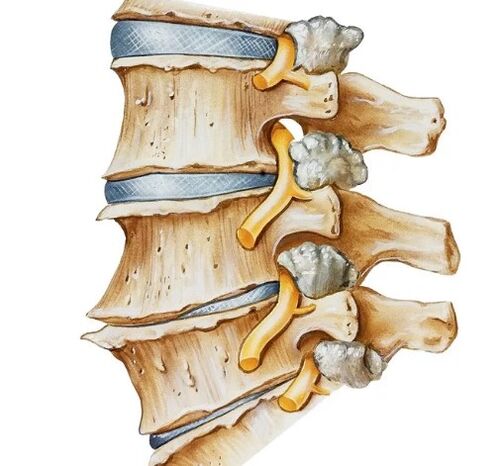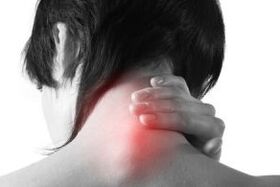InOsteochondrosis of symptoms and spine treatments of cervixThey will be different depending on the type of deformation in cervical vertebrates obtained in connection with long physical, inflammatory or mental effect on them.

The disease is often chronic, manifested many clinical symptoms caused by squeezing nerve roots and blood vessels that go out of vertebrae. Their compression is due to spending or deformation of intervertebral discs (reducing their height, loss of elasticity, deformations of fibrous rings or its rupture). Cervical osteochondrose is a common disease that occurs at any age after 20 years.
The reason for pathology is in destructive change of spine. First of all, changes in the interfaced discs: their elasticity, reduction of strength and height, their fibrous ring is deformed, protrusion (initial phase of interverter hernia). All these changes provoke bone growth in the vertebrae (osteophytes), lead to displacement, and later - the loss of mobility of the spine of the cervix. Since the spine is flexible protective "enclosures" for the spinal cord, destructive changes in the interflexia and loss of spinal flexibility are harmful to nerve and vascular structures of the spinal cord. They are subject to acquisition, displacement, which interfere with cerebral circulation and nigration not only the zone of shoulders and shoulders, but also internal organs, lower extremities.
Older patient, these are more intervertal discs changed under the influence of muscle weakening, long loads on spine, injuries, slowing physical activity, stressful situations and increased tensions in cramps, etc.

Due to its anatomical structure, cervix is more prone to pathology, because its spines are the most movable and very firmly in relation to each other. In addition, cervical spines have poor muscle protection. The most commonly degenerative changes develop in the most luxurious discs of the most cell phone 5. 6, 7 cervical vertebrae.
What are the symptoms of cervical osteochondrone
Variety and inconsistency of symptoms
Osteochondrosis of symptoms and spine treatments of cervixIt should be considered comprehensively and in combination with the type and weight of degeneration of intervertebral discs. The signs of cervical osteochondorosis are diverse and contradictory, because the localization and strength of the deformation process of interfere discs, the properties of the compression, or the location of the muscles and bodies, and with them are incorporated blood.
Therefore, often complaints on patients are not focused on neurologists, but also other experts: for example, cardiologist, therapist, otolarygologist, optometrist, rheumatologist, etc. At the same time, neuropathologist can give a diagnosis of cervical osteochondrose based on the results of the MRI brain and spine, brain ultrasound, ECG, etc.
Three sets of signs of damaged nervous system function
Experienced experts know about thirty different options combinations of cervical osteochondrose symptoms. Will not be possible to describe all the signs of the manifestation of this joint illness, so we stay onThree complexesMain symptoms characterized by certain damaged central nervous system functions.
The first complex of basic symptoms refers to the weakened function of the peripheral part of the nervous system. This department represents nerves and other elements that leave the brain and spinal cord, and are divided into somatic and autonomous systems.
In short, the first complex of cervical osteochondrosis symptoms was presented in the form of various localizations of pain. This does not mean that signs are only painful, often pain are combined with other damaged body functions. But mostly - these are constant or periodically neck pain, whose appears the patient is associated with hypothermia, extended stress or in an unpleasant loan, weight growing, sharp head.
Pain pain, shooting or similar shock. Their localization depends on the tensions of certain muscles associated with the specific roots of nerves, which are clenched with vertebrates. Therefore, pain can spread in the neck, tire, shoulder, one or both hands, radiates to the chest - to the area of the heart, liver. In addition, there are complaints on crumb or crackers in the vertebrates of the cervical region when the head moves, as well as the rigidity of rotary head movements.
In the acute start of disease pain and spasm muscles of the door force a patient to be in a pose with a head sloping and casting. Pain combustion can occur between shoulder blades if the vegetative cervix formations are compressed, and their blood supply is disturbed. Such pain usually increases with physical and emotional stress.
It is often swollen, pale and cooling hands, their numbness, quick heartbeat, heartache, narrowing or expansion of students, etc. Due to the weakened shoulder, symptoms of dystrophical change in the shoulder may occur. Patients complain about pain, inability to raise and take hands aside, stiffness of the hinge shoulder.
The second complex of cervical osteochondrosis symptoms occurs due to the damaged spinal cord function and is manifested by engine disorders.
Disorders The function of the spinal cord is happening due to its compression as a result of losing the fulpose core from the disk or injury with solid discs and growth (osteophytes). Depending on the exposure mechanism, the next motor disorder complex was observed: the stiffness of the occipital and cervical muscles, the weakness of the arms and legs, with increased leg muscles and weight loss and weight loss; Loss of temperature and sensitivity to pain; A strong fat fatigue, weakened coordination.
The third set of symptoms is characterized by blood supply disruptions in brain containers and cranial nerve pathology that appear due to deformations in cervical vertebrates. Symptoms of vascular pathology manifest.
Characteristic symptoms of vascular disorders:
- Neurotic conditions (irritability, longing, anxiety, fatigue, sleep disorders);
- unconsciousness; headache and dizziness; Nausea and vomiting;
- noise and ringing in ears, hearing loss;
- Visual disorders (obscuration in the eyes, fogs, blinks, visual impairment);
- The famous syndrome of mining (sore throat, a sense of foreign object, dryness, difficulty swallowing).
The symptoms of cervical osteochondorosis are unequivocally, and should be considered in the complex and depending on the pathological processes in the spine.
Only a qualified expert can deal with the clinical manifestations of this disease, they make the correct diagnosis and prescribe the correct treatment of the causes of detected disorders.
How to treat this disease
Osteochondrosis of symptoms and treatment of the mother thrilling depend on the state of the patient, the severity of the disease, the nature of the damage to the spine of cervix.
In acute period, hospitalization and medications may be needed. Usually use analgesics, new muscle blocks, muscular relaxants that mitigate muscle cramp; Chondroprotecters for nutrient fabric nutrition; Sedative drugs that die the nervous system, b vitamins, improvement of neuromuscular conductivity. Treatment of osteochondrose of the cervical spine is always long, and that should be complex.
During the remission period, when acute symptoms are absent, physiotherapy methods (electrophoresis, ultrasound, etc. ) are widely used, therapeutic physically educated, massage, as well as non-traditional procedures, for example, necessarily prescribed acupuncture.

A lot of conservative methods of osteochondrose treatment is known, which can stop the response of the disease. However, each patient needs an individual course of treatment taking into account the phase of the disease, the characteristics of the body, gender and age. The purpose of the treatment of cervical osteochondorosis is:
- Elimination of pain and edema at the site of inflammation.
- Relaxing tense neck muscles.
- Release of tight nervous roots.
- Increased blood circulation.
- Metabolism activation.
- Improving the power of intervertebral disks.
Targeted complex treatment can prevent the appearance of a rooster and intervertebral hernias.
In order for symptoms and treatment of osteochondrose and treatment do not start, and severe complications of the disease must begin to start timely treatment.

























